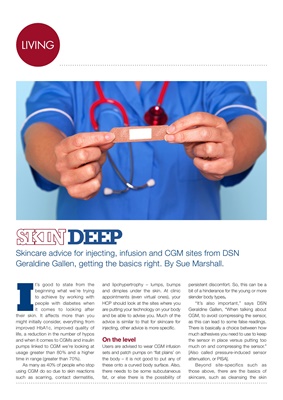
LIVINGLIVING
SKIN DEEP
Skincare advice for injecting, infusion and CGM sites from DSN
Geraldine Gallen, getting the basics right. By Sue Marshall.
It's good to state from the
beginning what we're trying
to achieve by working with
people with diabetes when
it comes to looking after
their skin. It affects more than you
might initially consider, everything from
improved HbA1c, improved quality of
life, a reduction in the number of hypos
and when it comes to CGMs and insulin
pumps linked to CGM we're looking at
usage greater than 80% and a higher
time in range (greater than 70%).
As many as 40% of people who stop
using CGM do so due to skin reactions
such as scarring, contact dermatitis,
and lipohypertrophy - lumps, bumps
and dimples under the skin. At clinic
appointments (even virtual ones), your
HCP should look at the sites where you
are putting your technology on your body
and be able to advise you. Much of the
advice is similar to that for skincare for
injecting, other advice is more specific.
On the level
Users are advised to wear CGM infusion
sets and patch pumps on 'flat plains' on
the body - it is not good to put any of
these onto a curved body surface. Also,
there needs to be some subcutaneous
fat, or else there is the possibility of
persistent discomfort. So, this can be a
bit of a hinderance for the young or more
slender body types.
"It's also important," says DSN
Geraldine Gallen, "When talking about
CGM, to avoid compressing the sensor,
as this can lead to some false readings.
There is basically a choice between how
much adhesives you need to use to keep
the sensor in place versus putting too
much on and compressing the sensor."
[Also called pressure-induced sensor
attenuation, or PISA].
Beyond site-specifics such as
those above, there are the basics of
skincare, such as cleansing the skin